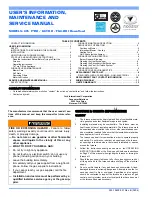
59SP6A: Installation, Start-up, Operating, Service and Maintenance Instructions
Manufacturer reserves the right to change, at any time, specifications and designs without notice and without obligations.
19
specification sheet for performance data for a particular filter media or
IAQ device.
Design the filter and associated ductwork for the best match of pressure
drop versus filter size. Best practice usually chooses filter systems with
pressure drops under 0.2 in. W.C. (50 Pa), with the best blower electrical
efficiency and system airflow performance occurring with filter pressure
drops under 0.1 in. W.C. (25 Pa).
Provide duct transitions, as required, to smoothly transition airflow from
the return duct system to the filter (or IAQ device) to the furnace when
the dimensions of the ductwork or furnace return air opening do not
match the required filter or IAQ device dimensions. See the instructions
supplied with factory-accessory duct adapters.
Leveling Legs (If Desired)
In upflow position with side return inlet(s), leveling legs may be used.
See
. Install field-supplied, 5/16 x 1-1/2 in. (8 x 38 mm) (max)
corrosion-resistant machine bolts, washers and nuts.
NOTE:
Bottom closure must be used when leveling legs are used. It
may be necessary to remove and reinstall bottom closure panel to install
leveling legs. To remove bottom closure panel, see
To install leveling legs:
1. Position furnace on its back. Locate and drill a hole in each bottom
corner of furnace.
2. For each leg, install nut on bolt and then install bolt with nut in
hole. (Install flat washer if desired.)
3. Install another nut on other side of furnace base. (Install flat washer
if desired.)
4. Adjust outside nut to provide desired height, and tighten inside nut
to secure arrangement.
5. Reinstall bottom closure panel if removed.
A89014
Fig. 26 – Leveling Legs
Location Relative to Cooling Equipment
The cooling coil must be installed parallel with, or on the downstream
side of the unit to avoid condensation in the heat exchangers. When
installed parallel with the furnace, dampers or other flow control must
prevent chilled air from entering the furnace. If the dampers are
manually operated, they must be equipped with means to prevent
operation of either unit unless the damper is in the full-heat or full-cool
position.
Platform Furnace Support
Construct working platform at location where all required furnace
clearances are met. See
. For furnaces with 1-in. (25
mm) clearance requirement on side, set furnace on non-combustible
blocks, bricks or angle iron. For crawlspace installations, if the furnace
is not suspended from the floor joists, the ground underneath furnace
must be level and the furnace set on blocks or bricks.
Suspended Furnace Support
The furnace must be supported under the entire length of the furnace
with threaded rod and angle iron. See
. Secure angle iron to
bottom of furnace as shown.
Roll-Out Protection
Provide a minimum 12-in. x 22-in. (305 x 559 mm) piece of sheet metal
for flame roll-out protection in front of burner area for furnaces closer
than 12-in. (305 mm) above the combustible deck or suspended furnaces
closer than 12-in. (305 mm) to joists. The sheet metal MUST extend
underneath the furnace casing by 1-in. (25 mm) with the door removed.
The bottom closure panel on furnaces of widths 17-1/2-in. (445 mm) and
larger may be used for flame roll-out protection when bottom of furnace
is used for return air connection. See
roll-out shield.
NOTICE
!
Design the duct system FIRST to determine how much pressure drop
may be allowed in the filter system. See the Air Ducts section.
Excessive filter pressure drop often compromises system airflow and
duct performance, causes inadequate airflow to the furthest ends of the
duct system, as well as causes excess noise and higher than anticipated
electrical consumption.
1
3
/
4
1
3
/
4
1
3/
4
1
3/
4
5/
16
5
/
16
5/
16
5/
16
(44mm)
(8mm)
(44mm)
(8mm)
(8mm)
(8mm)
(44mm)
(44mm)
















































